
This is a adding and subtracting polynomials assignment that includes an answer key and a QR code for students to check their own work.
- Subject:
- Algebra
- Math 1
- Material Type:
- Homework/Assignment
- Author:
- KORI ELLIOTT
- Date Added:
- 06/01/2020

This is a adding and subtracting polynomials assignment that includes an answer key and a QR code for students to check their own work.
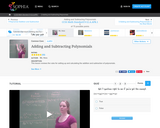
This lesson reviews the rules for setting up and calculating the addition and subtraction of polynomials.
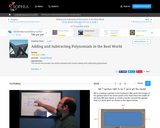
This lesson will provide real world examples that involve adding and subtracting polynomials.

CK-12 Foundation's Algebra I Teacher's Edition FlexBook complements CK-12's Algebra I Student Edition. The solution and assessment guides are available upon request.

Students use the commutative and associative properties to recognize structure within expressions and to prove equivalency of expressions.

Students understand that the sum or difference of two polynomials produces another polynomial and relate polynomials to the system of integers; students add and subtract polynomials.

Students understand that the product of two polynomials produces another polynomial; students multiply polynomials.

Students understand that factoring reverses the multiplication process as they find the linear factors of basic, factorable quadratic trinomials.
Students explore squaring a binomial, factoring the difference of squares, and finding the product of a sum and difference of the same two terms.

Using tiles to represent variables and constants, learn how to represent and solve algebra problem. Solve equations, substitute in variable expressions, and expand and factor. Flip tiles, remove zero pairs, copy and arrange, and make your way toward a better understanding of algebra.

CK-12 Foundation's Algebra FlexBook is an introduction to algebraic concepts for the high school student. Topics include: Equations & Functions, Real Numbers, Equations of Lines, Solving Systems of Equations & Quadratic Equations.

Students explore this interactive math tool and try to figure out what's happening on their own to discover the value of (a + b)^2?

Lesson with examples on combining linear expressions.

Khan video using the area model to multiply two linear expressions.
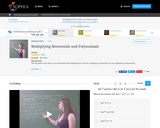
The purpose of this lesson is to show that when following the rules for multiplying, monomials can be multiplied by polynomials.
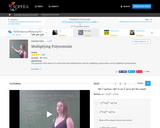
The purpose of this lesson is to show that when following the rules for multiplying, polynomials can be multiplied by polynomials.

This lesson uses the model of a 4 x 4 cube viewed from the top, front, and right side.The first task is to find the integer value representing the number of cubes that can be viewed as well as those that cannot be seen. The second task is to find a polynomial model that represents this solution. Besides drawing a picture and counting the cubes, think of a method which requires multiplication, addition, and subtraction of the sides that will result in a quadratic solution. Check the model and evaluating it when n=4 and compare answer to Task 1. The third task is to check to see if the model will hold true when the number of units in one side is greater than 4. The fourth task is an optional extension for students to predict a model for a rectangular prism with a square base using two variables. An addtional extension can be used to review probability and odds.

Instruction and practice on all operations with polynomials.

Students will continue to interpret expressions, create equations, rewrite equations and functions in different but equivalent forms, and graph and interpret functions, but this time using polynomial functions, and more specifically quadratic functions, as well as square root and cube root functions.

This is designed to be used as an assessment at the end of a unit on Polynomials. Studets are given requirements for the project but have the choice of using PowerPoint, Google Slides, Flipgrid, etc to represent their work.This was originally designed by Reed Bowman, Autumn Patterson, and Kori Elliott
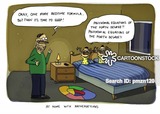
This is designed to be used as an assessment at the end of a unit on Polynomials. Studets are given requirements for the project but have the choice of using PowerPoint, Google Slides, Flipgrid, etc to represent their work.This was originally designed by Reed Bowman, Autumn Patterson, and Kori Elliott